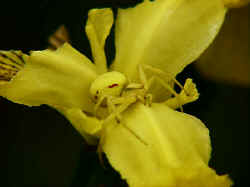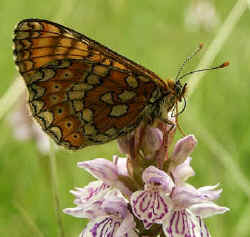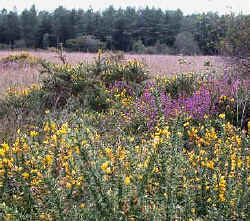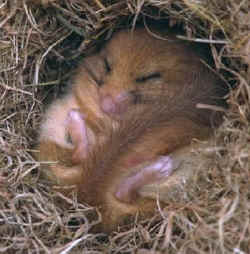| Q. |
What is a Biodiversity Action
Plan? |
| A. |
A
Biodiversity Action Plan (BAP) sets out the things which need to be done to help some
special wildlife to do well in a particular area. It also says who will do those
things and when. |
 |
| Q. |
What does Biodiversity mean? |
| A. |
Biodiversity simply means
'the great variety of life. In other words, the natural world, including all its
'wildlife'. This includes plant life from seaweeds to trees
and animals from bats to beetles. It also includes less well known wildlife, such as fungi
and bacteria |
|
| Q. |
What is the Devon Biodiversity
Action Plan? |
| A. |
The
Devon Biodiversity Action Plan (BAP) describes the actions which need to be taken now to
make sure that Devon's wonderful wildlife survives. The Plan cannot cover every species
and habitat in Devon. There are too many and it would cost too much money. It therefore
concentrates on the species and habitats which are either most in danger of disappearing
in Devon, or those which are most special to Devon. The overall Devon Biodiversity Action Plan includes 20 individual Species
Action Plans and 17 Habitat Action Plans. The Species Action Plans each concentrate on one
particular species, while the Habitat Action Plans aim to conserve whole habitats with all
their wildlife.
|
| Q. |
Which
species are included in the Devon Biodiversity Action Plan? |
| A. |
| Plants |
Animals |
| Devon Whitebeam
Primrose
Golden Hair Lichen |
Invertebrates
Freshwater Pearl Mussel
Great Green Bush-cricket
Marsh Fritillary
Pearl-bordered Fritillary
Pink Seafan
Southern Damselfly
White-clawed CrayfishFish
Atlantic Salmon
Birds
Barn Owl
Cirl Bunting
Curlew
Nightjar
Mammals
Brown Hare
Dormouse
Greater Horseshoe Bat
Otter
Water Vole
|
|
| Q. |
Which
habitats are included in the Devon Biodiversity Action Plan? |
| A. |
| Land |
Sea |
Freshwater |
Alder/willow Wet Woodland
Caves, Karst & Mines
Cities, Towns & Villages
Flower-rich Meadows
Lowland Heathland
Oak Woodland
Parkland & Wood Pasture
Pits, Quarries & Cuttings
Rhos Pasture
Sea Cliff and Slope
Species-rich Hedges |
Estuaries
Rocky Foreshore
Rocky Seabed |
Freshwater Reedbed
Grazing Marsh
Rivers, Streams & Floodplains
|
|
| Q. |
Why
is a Biodiversity Action Plan needed in Devon? |
| A. |
In common with
most other areas of Britain, habitats in Devon have been steadily declining. This means
that the wildlife they support is also declining. For
example, in South West England (which includes Devon), the area inhabited by Barn Owls has
decreased by 37% (over one third) in the past 25 years. |
 |
Devon is fortunate in
having Marsh Fritillary butterflies. Even so, it is estimated that 1 out of every 10
colonies of these butterflies disappears from Devon every 10 years. That may not seem a lot, but over a long time, if nothing is done, the
butterflies will eventually disappear. |
 |
Species need habitats
to support them. Without suitable habitat, no amount of well meaning actions will help to
preserve a species. It simply does not have what it needs to survive. One example of habitat loss is that of heathland in East Devon. Seventy five
percent (three quarters) of the heathlands present in 1936 have now disappeared.
The Devon BAP will try to promote the special species and habitats
identified and prevent further losses. |
| Q. |
Where did the idea for
Biodiversity Action Plans come from? |
| A. |
People all around the world
have been concerned for many years over the decline or loss of plants and animals which
were once common. Because people were so worried, in 1992, there was a famous
international conference in Rio de Janeiro, Brazil, known as the 'Earth Summit'.
At the Earth Summit, officials from many different countries, including Britain,
signed a document which promised that their governments would try to help wildlife and
preserve species. As a result of signing this document, the British Government has set up
countrywide national Biodiversity Action Plans (UK BAP) with the aim of helping rare or
threatened species and habitats in Britain.
Action Plans have also been produced for smaller areas all around the country. The
Devon Biodiversity Action Plan (BAP) is one of these. It concentrates on the species and
habitats that are special to the County of Devon. In many cases, this may also help with
the national Action Plans. |
 |
For
example, in many parts of the country, otters and dormice are rare. They are therefore
both included in the UK BAP. Devon is fortunate and has
populations of both otters and dormice. If there are lots of otters and dormice in Devon,
then there is a good chance that they will spread out into other suitable neighbouring
areas. This means that it is important that these two species continue to do well locally
and so they are included in the Devon Biodiversity Action Plan. |
| Q. |
Who is responsible for carrying
out the Devon BAP? |
| A. |
The actions which have been
identified in the Devon BAP are being carried out by many different groups acting in
partnership. This includes local government organizations such as Devon County Council, as
well as over 50 conservation, business and countryside groups. |
|